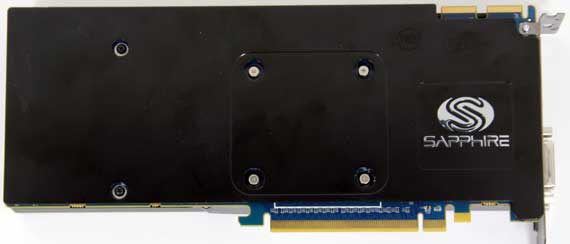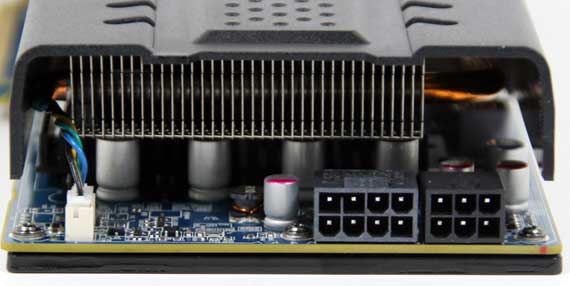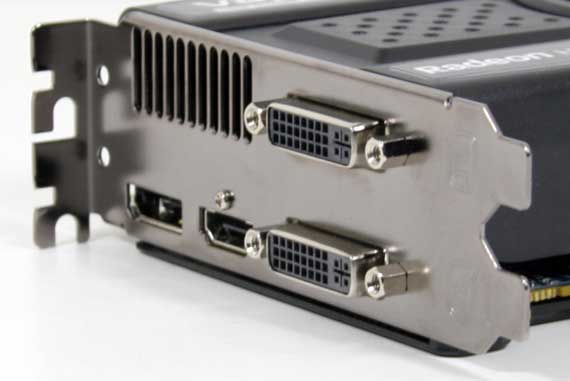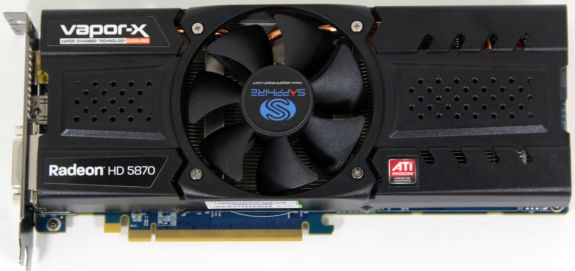Overclocked: Our Custom Radeon HD 5870 Roundup
by Ryan Smith on May 19, 2010 11:53 AM ESTSapphire Radeon HD 5870 Toxic 2GB
We’ll start things off with Sapphire’s Radeon HD 5870 Toxic. The 5870 Toxic 2GB is Sapphire’s shot at a custom 2GB Radeon HD 5870, forgoing AMD’s 5870E6 design for a design of their own. In this case Sapphire has ditched the Eyefinity 6 concept entirely, opting to build a card closer to a regular 5870 with 2GB of RAM. The result is a card that’s best described as a 2GB 5870, rather than a 5870E6.
The Toxic gets Sapphire’s customary touch, equipping the card with one of their famous Vapor-X coolers, the cornerstone of which is the use of a vapor chamber in the cooling assembly’s baseplate. The entire assembly is a card-sized aluminum heatsink connected to the baseplate by 3 heatpipes, with a 92mm fan in the center. Meanwhile the back of the card has a plate on it to serve double-duty as both a decoration and as a heatsink for the 8 128MB GDDR5 RAM modules on the back of the PCB. As with their other Vapor-X cooler products, the Vapor-X cooler on the Toxic is a partially covered design that blows air towards both the front and the rear of the card, so you’ll need a well-ventilated case for this card.

Moving on to the PCB, as with everything else this is a custom Sapphire design, a new design necessary to fit the extra 1GB of RAM. The card is 10.15” in length, making it shorter than the reference 5870. Unfortunately Sapphire also kept up their tradition of putting the PCIe power sockets on the rear of the card instead of the top, so it’s really 10.15” plus whatever room you need to maneuver your power cords. Speaking of which, since this is a 2GB 5870, the 5870 Toxic 2GB requires both 8pin and 6pin PCIe power to operate.

For component selection, Sapphire has decided to focus on their use of chokes and capacitors. Once again we see Sapphire’s grooved “Black Diamond” solid state chokes, and all of their capacitors are solid capacitors. As is the case with the rest of the cards in this roundup, this is as much a technical matter as it is a marketing matter: the reference 5870 design already uses solid state chokes and solid capacitors. So the difference comes down to component selection, with Sapphire using their higher quality chokes.
Sapphire is once again targeting the factory overclock market with the Toxic, shipping the card with a core clock of 925MHz and a memory clock of 1.225GHz (4.9GHz effective) – 75MHz and 100MHz faster than the stock 5870’s core and memory respectively. Since Sapphire isn’t targeting overclockers with this card it should come as no surprise that there’s little in the way of overclocking features for it. There is a generous overdrive limit of 1000/1500 for the card, but as it’s using Sapphire’s unprogrammable VRMs, there’s no way to change the GPU voltage. Making up for that is the card’s slightly higher default core voltage of 1.2v, necessary to drive the card’s higher core clock.

The included materials are also sparse: drivers, AnySim HD, power adapters, a VGA dongle, a CF bridge, and a generic multilingual manual.
Since this is not an Eyefinity 6 edition card, the port configuration is AMD’s standard Eyefinity configuration: 2xDVI, 1x DP, and 1x HDMI. The 2GB of RAM should also be of some help when it comes to Eyefinity, however as we saw in our 5870E6 review it’s limited at best.

The retail price of the card is around $500 – we briefly saw it at $489 before it went out of stock. Compared to the other cards in this roundup, the Toxic is going to be the hardest to find, as it’s currently out of stock everywhere we’ve checked. When in stock however, it’s priced close enough to the 5870E6 that they’re substitute products, so if you’re willing to give up 3 mini-DisplayPorts, you can get a factory overclocked 5870 instead.











43 Comments
View All Comments
dgz - Thursday, May 20, 2010 - link
Guys, you should really use Left 4 Dead 2 instead of the original game as the sequel is way more intensive on the system. The visual difference may not be stunning but the hunger for performance is there.Jumalauta - Thursday, May 20, 2010 - link
Very interesting roundup, thank you.Seeing how idle noise is basically The Gigabyte card's only flaw, I was wondering if you tried to remedy that by controlling the fan speed with MSI Afterburner software? It's VERY handy for creating custom fan speed curves. The only question is compatibility with Gigabyte's custom card.
sneakyB - Thursday, May 20, 2010 - link
This article comes at the best of time for me, I've been trying to decide for the last two weeks wich OCed 5870 to get. But I'm surprised that there's no Asus matrix in the review, maybe it's that we have it here in Europe and it's not on sale in the US ? I would have liked to see it compared to the Gigabyte, as my usual store has both for sale.FH123 - Thursday, May 20, 2010 - link
Was the Gigabyte clocking down properly on idle? I have a an Asus 5850, based on the reference design. Once you attach 2 monitors it no longer clocks down to something like 157MHz core / 300MHz memory, but instead idles at full speed 700MHz core / 1000MHz memory with a consequent rise in noise levels, which first alerted me to the fact.Jumalauta - Thursday, May 20, 2010 - link
If you take a look at idle GPU temps, I'd say the problem is elsewhere.FH123 - Thursday, May 20, 2010 - link
Agreed.Lonyo - Thursday, May 20, 2010 - link
You dropped Wolfenstein, one of the few OpenGL games, because of the way it responds, and yet you keep in Left 4 Dead, one of the most CPU limited games there is.Sounds like a great decision.
East17 - Thursday, May 20, 2010 - link
I think that there should be another chapter included in OC cards RoundUps :1)test the cards @ default settings (already done)
2)test the cards @ OC settings (already done)
3)try to see what PCB design and options are better by excluding the cooling limitation imposed by the specific coolers and test the cards @ OC setting WITH the best VGA cooler available at that time
I think this is a good idea and should be included in future reviews IMHO .
Have a nice day!
Jumalauta - Thursday, May 20, 2010 - link
You still wouldn't get anywhere due to GPU sample variance. You would need a lot of test samples of each variety to attain even remotely conclusive results.ajlueke - Thursday, May 20, 2010 - link
The fact that these cards are typically running around the $500 mark, which is the same price tag as an Nvidia GTX 480, is a deal breaker. You pay Fermi price without the Fermi performance. Stock 5870s can be had for $400 these days, and a sub 10% performance increase with a 25% price increase hardly seems worth it. It is possible to achieve similar overclocking results for less money and with less noise with a good after market cooler.